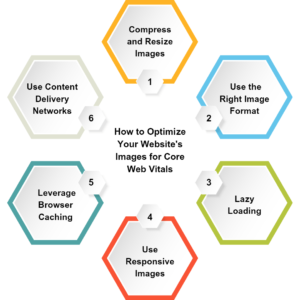Having a well-optimized website is crucial for online success. With Google’s emphasis on user experience, Core Web Vitals has become an important factor in search engine rankings. One key aspect of optimizing your website for Core Web Vitals is optimizing your images. In this blog post, we will explore effective techniques to optimize your website’s images, improving your site’s performance and user experience.

Compress and Resize Images:
Large image files can significantly impact your website’s loading speed. By compressing and resizing images appropriately, you can reduce their file size without compromising quality. There are several tools available online, such as TinyPNG, JPEG Optimizer, or Squoosh, that can help you compress images without sacrificing visual appeal. Aim for a balance between image quality and file size to ensure faster loading times.
Use the Right Image Format:
Choosing the correct image format is essential for optimization. Different image formats serve different purposes. For photographs or images with complex color gradients, JPEG is generally the preferred format. For images with sharp lines and transparency, such as logos or icons, consider using PNG or SVG formats. By using the appropriate format, you can ensure optimal image quality while minimizing file size.
Lazy Loading:
Implementing lazy loading on your website can significantly enhance its loading speed. Lazy loading is a technique where images are loaded only when they appear in the user’s viewport, rather than loading all images at once. This technique reduces the initial load time and improves the overall performance of your website. There are many plugins and libraries available for various content management systems and frameworks that simplify the implementation of lazy loading.
Use Responsive Images:
With the increasing use of mobile devices, it’s crucial to ensure your images adapt to different screen sizes. Responsive images automatically adjust their size and resolution based on the user’s device, providing an optimal viewing experience. HTML’s `srcset` and `sizes` attributes allow you to specify different image sources for different devices, ensuring that users receive appropriately sized images for their screen resolution.
Leverage Browser Caching:
Enabling browser caching for your website’s images can significantly improve loading times for returning visitors. By setting an appropriate expiration time in the response headers of your images, you instruct the browser to cache the image locally. Subsequent visits to your website will then load the images from the cache, reducing the need to download them again. This technique helps enhance user experience and reduces the load on your server.
Use Content Delivery Networks (CDNs):
Content Delivery Networks, or CDNs, distribute your website’s content across multiple servers worldwide. When it comes to images, CDNs can deliver them from the server that is closest to the user’s location, reducing latency and improving loading times. By leveraging CDNs, you can ensure faster and more reliable image delivery, resulting in improved Core Web Vitals scores.
In Short, Optimizing your website’s images is crucial for achieving better Core Web Vitals scores, enhancing user experience, and improving search engine rankings. By following the techniques discussed in this blog post, such as compressing and resizing images, choosing the right format, implementing lazy loading, using responsive images, leveraging browser caching, and utilizing CDNs, you can significantly enhance your website’s performance. Remember, a fast-loading website with optimized images not only pleases users but also helps your business thrive in the competitive online landscape.
Check out our Previous Blogs- Keep Up With All The Latest In The Digital World







